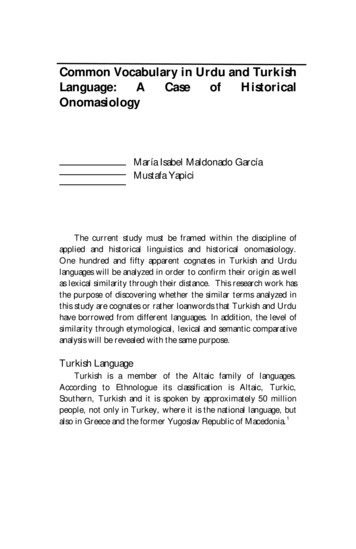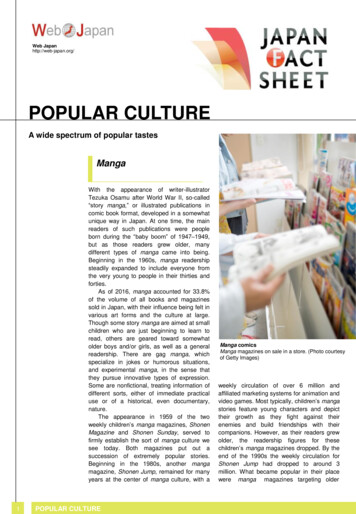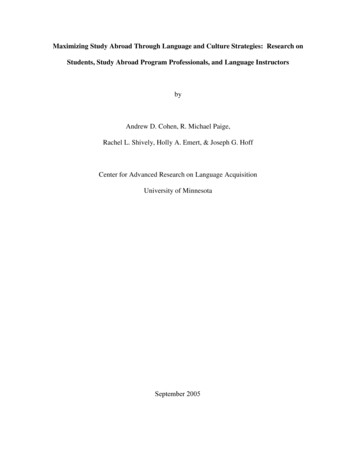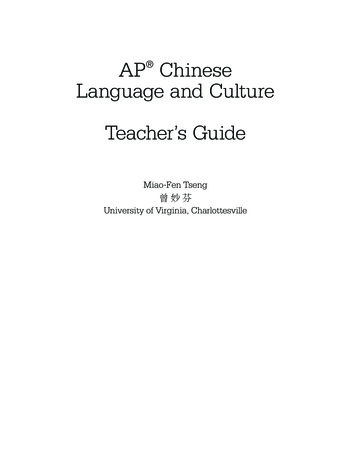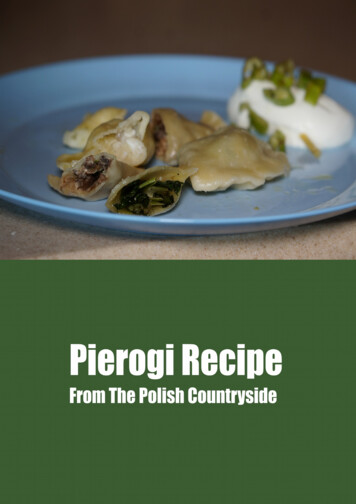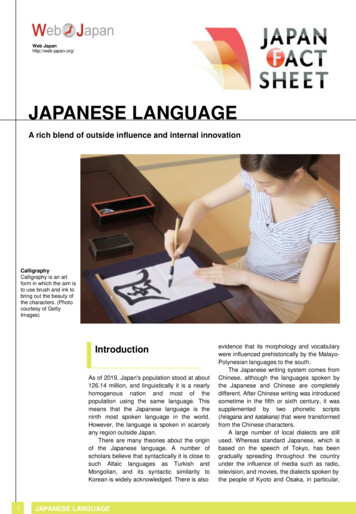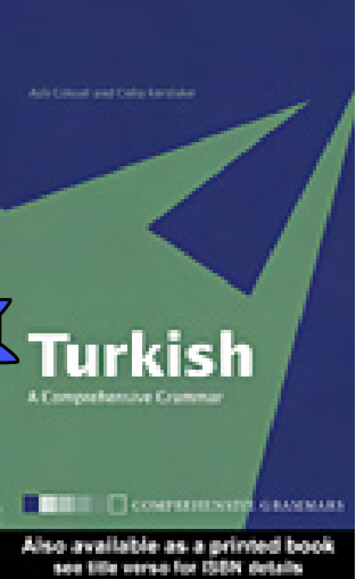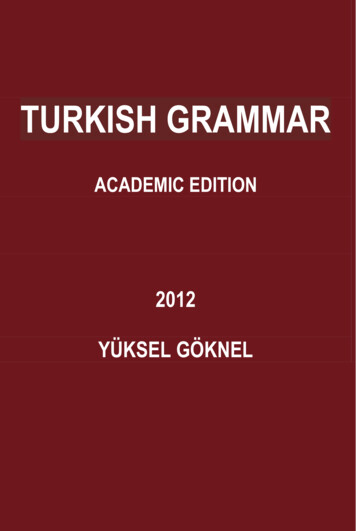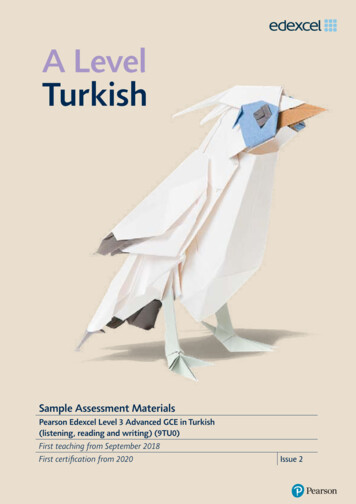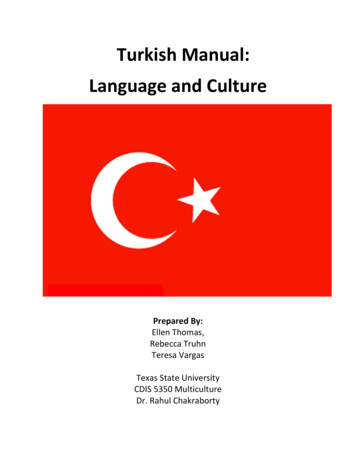
Transcription
Turkish Manual:Language and CulturePrepared By:Ellen Thomas,Rebecca TruhnTeresa VargasTexas State UniversityCDIS 5350 MulticultureDr. Rahul Chakraborty
2Table of Contents** This is a compendium of materials; the presenters are not claiming ownership of theinformation. This language manuals‘ purpose is to serve as a reference.Demographics and Language 4Demographics of Turkey 4Ethnic Groups 4Religion .5Politics and Government .5Economy and Employment . . .5Language Spoken in Turkey .5Linguistic Community .5Geographical Distribution 6Population in the United States and Canada .7Linguistc Features .7Phonology .7Morphology .9Syntax .10Pragmatics 12Common English Pronunciation Errors made by Turkish Speakers .13Child Language Acquisition 15Language Differences: English and Turkish .15Alphabet .15Phonology .15Grammar- Verb/Tense 15Grammar- Other .15
3Vocabulary .15Tests & Assessment Materials 16Therapy Material .16Common Phrases in Turkish .17Culture of Turkey 17Food 17Family Dynamics 18Clothing .19Customs and Traditions .19Evil Eye .19Coffee House Culture .19Turkish hospitality .20History of Turkey 20Interpreter Services in Austin area 22Interview with a Turkish- American .22Web Resources 24Turkish Cuisine .24Turkish Language .24Turkish History .24Turkish Traditions .25Research Articles .25References .27
4Demographics and LanguageTurkish is the official language in the Republic of Turkey, spoken by 90% of its population. It is the 15thmost widely spoken language in the world. Approximately 77 million people speak Turkish s2.html and http://en.wikipedia.org/wiki/Turkish languageTurkey is located in South Eastern Europe and shares borders with Bulgaria, Greece, Georgia, Armenia,Iran, Iraq, Syria. It also borders with the Black Sea, the Mediterranean Sea, and the Aegean Sea.The capital of Turkey is Ankara. The Turkish government‘s political structure is a republicanparliamentary s/global-etiquette/turkey-country-profile.htmlMap from: http://en.wikipedia.org/wiki/Turkish languageDemographic of TurkeyEthnic GroupsThe population of Turkey (December 2009) was estimated to be 72.5 million people. About 80% of thepopulation is Turkish. The major ethnic minority (by mother tongue), the Kurds, is estimated at 20%.Arabs, Turkmen, Circassians, Greeks, and others do account for a small percentage of the population.
ia/Turkey-ETHNIC-GROUPS.html ey is a secular state with no official state religion. However, the main religion practiced in Turkey isMuslim with an affiliation of 99.8% (mostly Sunni). The other 0.2% is made up mostly of Christians cs and GovernmentBefore the 1970s, there was very little Turkish American involvement in American politics. The Turkishinvasion of Cyprus in 1974, however, mobilized many individuals because of U.S. government supportfor the Greeks. Nonetheless, the small Turkish American community was not able to counter theinfluence of the much larger and more powerful Greek American organizations. Turkish Americansproudly point to Turkey's membership in NATO and its military and political support of the U.S.government during the 1991 Persian Gulf War.Economy and EmploymentEarly Turkish immigrants to the United States were predominantly from Turkey's rural community. Theysettled in large, industrial cities and found employment as unskilled laborers. The majority came to earnmoney so that they could improve their economic situation and that of their families in Turkey. After the1950s, a well-skilled and highly educated class immigrated to the United States, the majority beingmedical doctors, engineers, and scientists. Today, Turkish Americans are visible in virtually every field.The majority are professionals and enjoy a middle-class urkish-Americans.htmlLanguages Spoken in TurkeyThe official language of Turkey is Turkish with 90% of the population speaking it. Minority languagesinclude Kurdish spoken by 6% of the population. Arabic is spoken by 1.2% of the Turkish population;however, most of those are bilingual Arabic and Turkish speakers. Other minority languages includeCircassian, spoken by more than 0.09% throughout the country, Greek, Armenian and Judezmo, aRomance language spoken by icsLinguistic CommunityTurkish is part of the Ural- Atlantic languages. The official standard language of Turkey is IstanbulTurkish. However, like the other languages of the world, Turkish has various dialects that have been
6shaped by the mass media as well as by the Turkish education system. The various types of dialects ofTurkish are presented in the table below:RegionDialectRumeliaRumeliceAlso includes the distinct dialects (influencedby Balkan linguistic union) of:- Deliorman- Dinler- Adakale,EdirneEdirneCypriotKibris (Cypriot Turkish)Aegean Region to AntalyaEgeMediterranean Region Of TurkeyYörükSoutheast to the east of MersinGüneydoğuEastern AnatoliaDoğuCentral AnatoliaOrta AnadoluEastern Black Sea RegionKaradenizKastamonuKastamonuEastern group of Hamsheins around ArtvinHemsinli/ Hemsince (influenced by Armenian)GreeceKaramanlica/ Kαραμαvληδικα h languageGeographical DistributionTurks primarily live in Turkey. Regions of Turkey with the largest populations are İstanbul ( 12million), Ankara ( 4.4 million), İzmir ( 3.7 million), Bursa ( 2.4 million), Adana ( 2.0 million) andKonya ( 1.9 million). Turks can also be found in the surrounding areas of Turkey such as NorthernCyprus (Turkish Cypriots), Greece, Bulgaria, Albania, Bosnia and Herzegovina, the Republic ofMacedonia, the Dobruja region of Romania, Pakistan, the Sandžak region of Serbia, Kosovo, Syria andIraq.After World War II there was migration of the Turks into Europe under the Labour Export Agreement, asa result many Turks settled in Germany, Netherlands, Belgium, and Austria as well as in the UnitedKingdom. It is estimated that there 100,000 Turkish and 130,000 nationals of the Turkish Republic ofCyprus are currently living in the United Kingdom. These high numbers of Turkish individuals, makesthe United Kingdom the third largest Turkish community in Europe.Extending from Europe, individuals of Turkish descent can also be found in smaller number in Chile(1,000), Brazil (5,000), and Mexico (fewer than 2,000).Turks can also be found in some parts of the United States and Canada.
7http://en.wikipedia.org/wiki/Turkish peoplePopulation in the United States and CanadaIn the United States, the greatest number of Turkish- Americans have settled in Paterson, New York City(mostly in Brooklyn), Boston, Chicago, Detroit, Philadelphia and Rochester. Other concentrations ofTurkish Americans may be found along the East Coast in New York, New Jersey, Connecticut, Marylandand Virginia; and some have ventured into California (esp. Los Angeles), Minnesota, Indiana, Texas,Florida and Alabama. There has also been an increase in the population of individuals of Turkish descentin Canada. While the majority of Turkish immigrants have settled in Montreal and Toronto, Turkishindividuals can also be found in Calgary, Edmonton, London, Ottawa, and Vancouver. The population ofTurkish Canadians in Metropolitan Toronto may be as large as 5,000.http://en.wikipedia.org/wiki/Turkish peopleLinguistic FeaturesPhonologyTurkish VowelsTurkish vowels are traditionally represented in a ‗cube‘ shape, consisting of all possible values of thefeatures, front/back, high/low, and rounded/unrounded, as in Figure 1. Each vowel can occur long, fromthe deletion of ğ, and the vowels /e i a u/ can occur long in Arabic loanwords, giving a total of 16 vowelphonemes. The vowel letters are for the most part self-explanatory, except for ı, an undotted ‗i,‘ which isa high back unrounded vowel, IPA [ ]. All Turkish vowels are phonetically lax, except sometimesbefore y or ğ, thus a e i ı o ö u ü sound like [iœ y]. Because the difference between ı and i isdistinctive, it must be maintained for capitals also, i.e., I and .Figure 1. Turkish vowels. Front vowels are represented at the front of the cube, high vowels are at the top, and rounded vowelsare to the right. Reproduced with permission from MIT Press.
8StressStress in Turkish consists of higher pitch, rather than greater loudness on the accented syllable. Stress isnormally on the last syllable of the word; as affixes are added, stress moves rightward.Vowel HarmonyVowel harmony involves the two features front/back and rounded/unrounded. It is a syllable-to-syllableprocess by which each vowel conditions the following vowel, according to the following rules:1. Any of the vowels can occur in the first syllable of a word.2. A noninitial vowel assimilates to the previous vowel in frontness.3. A noninitial high vowel assimilates to the previous vowel in rounding. A noninitial low vowel isunrounded. Thus /o ö/ do not appear in harmonic suffixes.Turkish ConsonantsThe International Phonetic Association (IPA) representations of the Turkish consonant system are shownin Table 1. Turkish uses 21 letters for consonants: b c ç d f g ğ h j k l m n p r s ş t v y z. These representthe expected sounds, except as follows:Letter Soundc[d ]ç[t ]j[ ]ş[ ]In the following discussions, [t ] and [d ] will henceforth be written /č/ and / /, since they function inall phonological respects as members of the natural class of stops, not as clusters. The letters k g l eachstand for two sounds: a plain velar or lateral [k l] and a front velar or palatal [c ]. In words ofTurkish origin, the front velar variant occurs with front vowels and the plain velar occurs with backvowels. In words of Arabic origin, however, /c / can occur with back vowels, giving rise to pairs andthus distinctive contrasts, as in kar ‗snow‘ [k r] and kâr ‗profit‘ [c r].Table 1. International Phonetic Association symbols for Turkish consonants
ks/0080448542MorphologyTurkish is an agglutinating language in which suffixes, in some cases a large number of them (the lists ofsuffixes in the following sections are not exhaustive), are added fairly transparently to stems:(2) ev‗house‘evler‗houses‘evlerim‗my houses‘evlerimiz‗our houses‘evlerimizde ‗in our houses‘evlerimizdeki ‗which is in our houses‘The Noun ParadigmNoun stems may have the following inflectional suffixes, in order:1. Plural -lAr (as in baba ‗father‘, babalar ‗fathers‘ and deve ‗camel‘, develer camels).2. Possessive (possessed agreement).3. Case (as in oda ‘room‘).(3) Nominative:OdaGenitive (-(n)In):odanınDative (-yA):odayaObjective (-yI):OdayıLocative (-DA):odadaAblative (-DAn):odadanInstrumental/comitative (-y-lA): odaylaThe Verb ParadigmStarting with the verb root, a number of derivational suffixes can be added to build up the verb stem.These include reflexive, reciprocal, causative, passive, impossibility, negative, and abilitative forms. Atthis point, from the verb stem, it is possible to go in a number of directions. For a finite (‗tensed‘) verb,the next step is a tense suffix, followed normally by a personal ending:(4) General present: gelirim‗I come‘, ‗I'll come‘Progressive:geliyorum ‗I am coming‘(Definite) past: geldim‗I came‘Unwitnessed past: gelmişim ‗I (supposedly) cameFuture:geleceğim ‗I will come‘Necessitative:gelmeliyim ‗I ought to come‘Optative:geleyim‗let me come‘Conditional:gelsem‗if I come‘
10There is also a wide range of nonfinite suffixes possible at this point for the formation of subordinateclauses. These include verbal nouns or nominalizations, participles, and adverbial clause suffixes(traditional ‗converbs‘).Auxiliary SuffixesFinally, there is a group of suffixes that can be categorized under the heading of ‗auxiliary‘. They can beadded both to verbal and nonverbal predicates, hence a separate auxiliary category. They include mostprominently the personal endings, but also some morphemes that can be called ‗aspects‘, although theyare not all aspects any more than the tenses are all tenses (abbreviations: sg, singular; prog, progressive):(5) Yorgun -du -m.tired -past –1sg‗I was tired‘.(6) Gel -iyor -du -m.come -prog -past -1sg‗I was coming‘.The aspects are past -y-DI, dubitative -y-mIş, and conditional -y-sA. Furthermore, there is an adverbialaspect -y-ken. These look very similar to some tenses, i.e., definite past -DI, unwitnessed past -mIş, andconditional –sA, but they differ in morphology, meaning, and prosody (all auxiliary suffixes areprestressing).The
Turkish vowels are traditionally represented in a ‗cube‘ shape, consisting of all possible values of the features, front/back, high/low, and rounded/unrounded, as in Figure 1. Each vowel can occur long, from the deletion of ğ, and the vowels /e i a u/ can occur long in Arabic loanwords, giving a total of 16 vowel phonemes. The vowel letters are for the most part self-explanatory, except .
